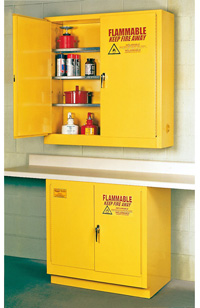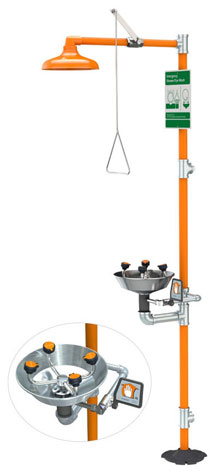| The Home page of ILPI's Safety Data Sheet (SDS) Resource, the leader in SDS information since 1995! | |
| The history and philosophy behind this resource. | |
| A curated collection of books and reference materials concerning Safety Data Sheets and closely related topics. | |
| Paste your plain text SDS into the SDS-Demystifier, and it will be converted into a hypertext-enriched document with links to detailed explanations of each key term. | |
| An extensive list of frequently asked questions about Safety Data Sheets including regulations, content, compliance, and more. | |
| A humorous take on Safety Data Sheet jargon. Fill in the blanks on our entry form to generate a personalized Unsafety Data Sheet to share with your coworkers. | |
| Since 1995, we've maintained this massive curated list of the best places to find Safety Data Sheets on the Internet. | |
| You are here! Way more than a glossary, this hypertext-enhanced resource covers hundreds of SDS-related terms and expert knowledge. Each entry includes both the SDS relevance and links to additional authoritative resources. | |
| Archived results of Safety Data Sheet related polls taken by some of our millions of site visitors | |
| The OSHA regulations behind SDS regulations, including the inspection guidelines and over 400 official interpretations letters under the Hazard Communication Standard | |
| Commercial suppliers of SDS authoring and management software as well as cloud compliance services. | |
| Commercial companies that will create SDS's for your specific needs as well as SDS translation companies. |

Safety signs, banners, and scoreboards? Get yours at Safety Emporium!
Definition

Store your aerosol cans safely with flammable storage safety cabinets from Safety Emporium.
Flammable limits apply generally to vapors and are defined as the concentration range in which a flammable substance can produce a fire or explosion when an ignition source (such as a spark or open flame) is present. The concentration is generally expressed as percent fuel by volume.
- Above the upper flammable limit (UFL) the mixture of substance and air is too rich in fuel (deficient in oxygen) to burn. This is sometimes called the upper explosive limit (UEL).
- Below the lower flammable limit (LFL) the mixture of substance and air lacks sufficient fuel (substance) to burn. This is sometimes called the lower explosive limit (LEL).
Any concentration between the upper and lower limits can ignite or explode - use extreme caution! Being above the upper limit is not particularly safe, either. If a confined space is above the upper flammable limit and is then ventilated or opened to an air source, the vapor will be diluted and the concentration can drop into the flammable limit range.
Additional Info
Using a flammable material in a confined space without proper ventilation or engineering controls is asking for trouble. It is usually quite easy to reach the lower flammable limit. There are numerous cases where individuals have used a solvent, sealer, or other flammable materials such as acetone in a basement or closed room with inadequate ventilation and been severely burned and injured when the vapors were ignited by a pilot light, electric spark or other ignition source. Here's an example of one with a horrific burn injury that resulted in a $10.9 million jury award and another causing severe burns to three workers.
In laboratories, special precautions against accidental spark sources need to be taken whenever a chemical is used in closed space such as a fume hood or laboratory refrigerator. Special explosion-proof or explosion-resistant equipment (refrigerators, hot plates, stir plates etc.) should be used in these situations. The better solutions have the controls and thermostats located outside of the work or storage zone with as few electrical connections as possible on the inside. The best solutions are called intrinsically safe in that they have no inherent spark source. For example, stir plates can be driven by compressed air instead of an electric motor.
A spectacular example of the consequences of introducing a spark to a flammable limit atmosphere occurred in Newcastle, Australia in September of 2003. A pipe fitter left an acetylene cylinder inside his vehicle over the weekend. Either the cylinder had a small leak or the valve was not fully closed. The flammable limits for acetylene are extremely broad, 2.5% to 100% in air.
When the worker opened the door, an undetermined spark source (the door light switch, light bulb, cellular phone, static etc.) ignited the mixture with catastrophic results:


In the close-up view, notice how the roof/door pillars are bent completely sideways. It is amazing that the worker's injuries were confined to his face and ear drums.
In 2013, a similar incident occurred in Stoneham, MA. The driver escaped injury only because she used her remote key fob to activate the door locks (and thereby trigger the explosion of the welding gases in the trunk).

Safety Emporium carries all kinds of eye/face washes, safety showers, drench hoses and more.
SDS Relevance
If applicable and known, flammable and explosive limits will appear in Section 9 (physical and chemical properties) of the Safety Data Sheet.
When working with a
Always work with volatile substances in well-ventilated areas or use appropriate engineering controls. Even then, you may need to measure or calculate the concentration of the vapor to ensure that it does not reach the flammable limit range.
Flowing liquids can generate static electricity. When transferring liquids from one container to another, be sure to follow proper bonding and grounding procedures.
Further Reading
- Lower and Upper Explosive Limits for Flammable Gases and Vapors (LEL/UEL) at Chrysalis Scientific Technologies covers several dozen chemicals.
- This solvent information page at Purdue University includes the explosive limits for approximately 20 common laboratory solvents.
- Gases - Explosive and Flammability Concentration Limits at The Engineering Toolbox.
- Lower and Upper Explosive Limits for Flammable Gases and Vapors from Werner Sölken has info on the topic as well as data for a few dozen chemicals.
- The ASTM standard "E681-09 Standard Test Method for Concentration Limits of Flammability of Chemicals (Vapors and Gases)" is available for purchase through their web site.
- This OSHA Training And Education document covers Flammable and Combustible liquids (29 CFR 1910.106).
- The Dangerous Mix Of Gas Water Heaters, Flammable Vapors at the Hartford Courant.
- Flammability limit testing is offered by several companies including Dekra, Sigma-HSE, and Fauske & Associates.
See also: combustible, flammable, flash point, vapor pressure, VOC.